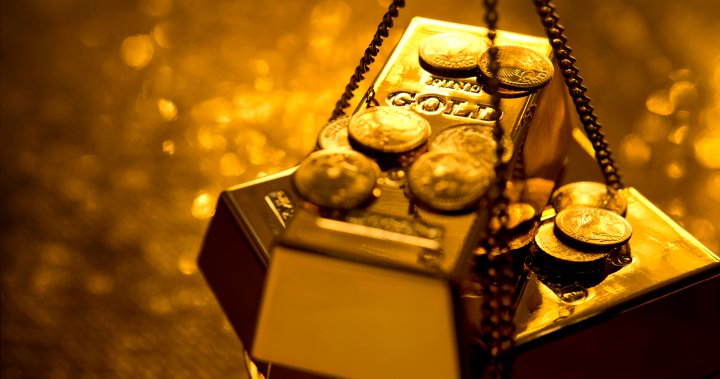A surge in the value of gold has given the precious metal a new glint in the eyes of investors.
The spot price of gold hit a peak of US$2,135.40 on Monday. It’s since cooled from those all-time highs but continues to hover around US$2,000 per ounce.
Experts who spoke to Global News say there are a few ways you can get exposure to the commodity in your portfolio, though some question the value of joining a modern gold rush.
A few simultaneous factors have been combining to drive gold values higher since early October, says Allan Small, senior investment advisor with iA Private Wealth.
Gold’s reputation as a safe haven and an alternative to the U.S. dollar makes it an attractive store of value in times of “chaos” and when the greenback is faltering, he tells Global News.
The Israel-Hamas conflict that’s been ongoing since October is one factor likely pushing gold’s value higher, Small explains.
Gold has actually been having a moment globally for a couple of years now, Greg Taylor, chief investment officer at Purpose Investments, says.
Central banks’ flood of stimulus into global markets during the COVID-19 pandemic pushed many investors into assets they felt were outside the traditional banking system, with cryptocurrencies and gold among the popular choices, he tells Global News.
North American investors didn’t necessarily benefit from this run, however, because gold is traded in U.S. dollars on this side of the Atlantic, which has also pushed higher over that time. Japanese or European investors, on the other hand, have benefited from gold’s rally already, Taylor explains.
But more recently, the U.S. dollar has taken a hit amid changing expectations about interest rates south of the border. The U.S. Federal Reserve’s change in stance over the past few months has prompted some market forecasters to expect rate cuts from the central bank — something that has a deflating effect on the American dollar, which tends to rise alongside interest rates.
“We’re catching up to the party that the rest of the world has had in gold,” Taylor says.
With growing global uncertainty striking at the same time pressure mounts on the U.S. dollar — another traditional safe haven — investors are looking for other areas they can “hedge” against these downward forces in the market, Small says.
While gold has seen its price soar, he also notes that bitcoin and other cryptocurrencies are enjoying a renewed boost in value as an alternative to the U.S. dollar.
“I don’t think it’s any coincidence that you’re seeing crypto and gold … moving higher as the U.S. dollar struggles under the weight of perhaps a lower interest rate environment to come in 2024,” Small says.
Costco made headlines in September when it announced it would start selling gold bars off the shelf to everyday consumers, with the retailer seemingly struggling to keep up with demand.
Taylor says he thinks the novelty of owning physical gold is coming back amid growing distrust in traditional banking systems, citing fears of banking instability in the U.S. and parts of Europe earlier this year.
Having a gold bar, for example, is an asset perceived to be outside the reach of banks and governments, which he says can “alleviate some of that stress” for skeptical investors.
Some investors will hold physical gold, typically coins or bullion, in a safety deposit box in hopes its value will appreciate over time.
Taylor notes that there are risks to this approach as well, as gold bars are not tracked or insured in the same way other equities are, and will cost money over time to store in a vault.
For any Canadians eyeing their jewelry collections and wondering if they can score a better deal today for a gold ring or bracelet, Small says it could indeed be a good time to visit the pawn shop.
“I think that if you went to sell that piece of gold jewelry, I think today, two years later, yeah, you probably can get more for that,” he says.
Small warns, however, that sellers shouldn’t expect to get the same value per ounce from their local gold buyer as the spot price on the market.
“You’re going to get something lower. There’s no doubt about that,” he says.
But for investors who just want a bit of exposure to the commodity, there are less labour-intensive ways to get gold in their portfolio.
Gold certificates, for example, will entitle the owner to a share of gold without having to physically store any heavy metals.
Elevated gold prices can also push up the value of mining companies in the sector, Small says, though it’s not always a one-to-one comparison. A mining company’s stock could suffer due to factors like mismanagement or high expenses weighing on profitability despite higher gold prices, he notes.
More common for investors is to buy a gold exchange-traded fund (ETF), which collects a series of companies in the sector together. You can usually expect more stable returns here, Small says, with other companies offsetting an individual mining firm’s drawbacks.
Despite the recent run-up in value, Small concedes that he’s “not a big gold bug.”
Unlike other commodities like oil or metals such as copper, which has a practical use in homebuilding, he notes gold’s value is more “speculative” in nature and doesn’t follow traditional supply-and-demand patterns.
For Small, gold exists as a “hedge only,” and he takes issue with its value only rising at the “demise of something else” — in this case, the U.S. dollar.
“If there’s fear in the world … that’s when gold seems to have its appeal,” he says.
Taylor says there is a place for assets like gold in a portfolio, adding it doesn’t need to see “parabolic” growth to have value for investors.
He says crypto, commodities and other real assets like gold can be a “bit of a buffer” next to equities and fixed-income products in a basket of investments, as they’re “less correlated to the economic cycle.” He says the traditional wisdom is that five per cent of a portfolio should be held in real assets.
As a commodity that thrives during times of “duress,” Taylor says the shine isn’t likely to wear off gold any time soon.
“There is still a lot of stress out there … there’s a lot of people worried about the financial system and also geopolitics doesn’t seem to be getting any better over time,” he says. “So gold is something investors should look at.”
— with files from Global News’ Anne Gaviola




